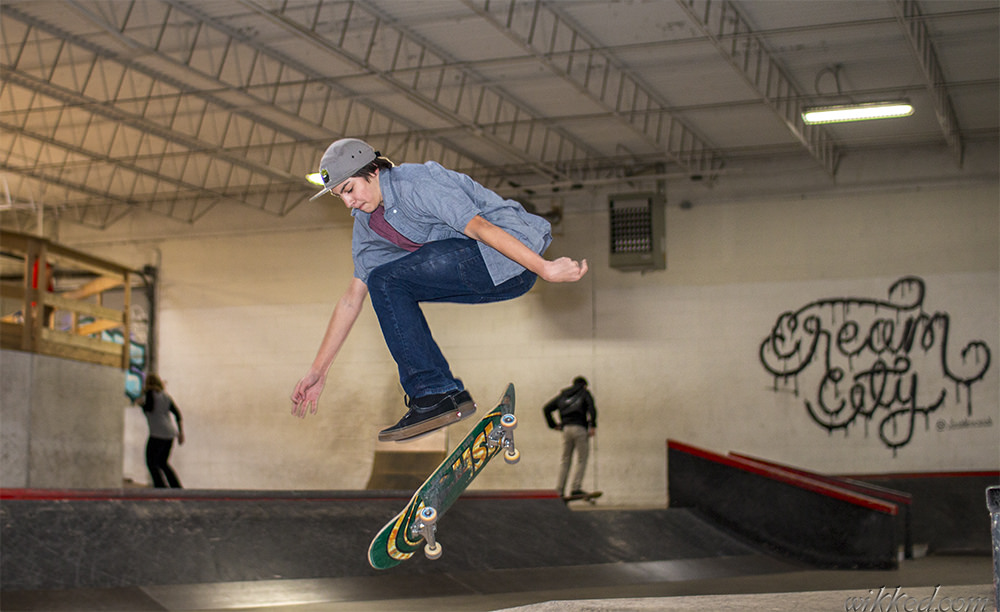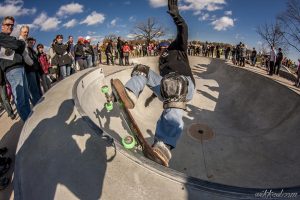A California import, skateboarding appeared in Milwaukee in the 1960s and rose in popularity in the 1970s.[1] Local authorities perceived skating as dangerous and wasted little time banning it from most public places.[2] According to contemporary accounts, this led to confrontations between skaters and authorities, which supported skateboarding’s outsider image.[3] Nevertheless, skaters careened down the smooth ramps of local schools until campus police intruded, while hotshots performed tricks at “the spot” in Greenfield Park.[4] The famous concrete pools at Turf Skatepark in Greenfield functioned as skateboarding’s area headquarters, attracting the nation’s top teams and local youth alike through the mid-1990s.[5] Forty years on, skateboarding’s rebellious spirit remains, but the growing number of well-maintained skate parks in the area attest to its increasingly mainstream status.[6]
Footnotes [+]
- ^ James Davis, Skateboarding Is Not a Crime: 50 Years of Street Culture (Buffalo, NY, and Richmond Hill, Ontario: Firefly Books, 2004), 10-12; Jay Scriba, “Skateboarders Set for Takeoff Here,” The Milwaukee Journal, April 27, 1979, accessed March 17, 2014, http://news.google.com/newspapers?nid=1499&dat=19790427&id=U10aAAAAIBAJ&sjid=OyoEAAAAIBAJ&pg=6894,5154795; Skateboarding enjoyed a brief period of popularity in Milwaukee in the mid-1960s, but the sport did not truly gain traction until the invention of the polyurethane wheels, which replaced clay wheels and gave riders vastly improved control.
- ^ Lee Bergquist, “Ramping It Up a Notch—Skateboarding Gaining New Acceptance,” Milwaukee Journal Sentinel, July 7, 2005, accessed March 18 2014, http://news.google.com/newspapers?id=1QEdAAAAIBAJ&sjid=VY4EAAAAIBAJ&pg=6033%2C195468; As to the degree of danger inherent in skateboarding, see Neil D. Rosenberg, “Skateboard Injuries Soar,” The Milwaukee Journal, May 10, 1977, accessed March 24, 2014, http://news.google.com/newspapers?nid=1499&dat=19770510&id=EcQqAAAAIBAJ&sjid=mH4EAAAAIBAJ&pg=2751,6578052, and Jay Scriba, “Skateboarders Set for Takeoff Here,” wherein the author notes that skaters began to wear pads by the end of the 1970s, making the sport safer.
- ^ Bergquist, “Ramping It Up a Notch.”
- ^ Jay Scriba, “Skateboarders.” The spot—an informal hotspot—featured an open concrete tube, where skaters could practice tricks such as the “Kamikaze” and “two-board daffies.”
- ^ Ken Darling, “Skateboard Enthusiasts Get Greenfield Park Rolling” The Milwaukee Sentinel, November 19, 1987, accessed March 16, http://news.google.com/newspapers?nid=1368&dat=19871119&id=3EMxAAAAIBAJ&sjid=nxIEAAAAIBAJ&pg=5892,3739098; Kathy Nichols, “Surfin’ the Turf,” ThirdCoastDaily.com, September 10, 2010, accessed March 17, 2014, http://thirdcoastdaily.com/2010/09/10/surfin-the-turf/; Turf Skateboard Park was located at 4267 W. Loomis Rd.
- ^ Lee Bergquist, “Ramping It Up a Notch.” As of 2014, skateboarding on Milwaukee streets is illegal and skateboards are classified in the same category as unicycles.
For Further Reading
Brooke, Michael. The Concrete Wave: The History of Skateboarding. Toronto: Warwick Publishing, 1999.
Davis, James. Skateboarding Is Not a Crime: 50 Years of Street Culture. Buffalo, NY and Richmond Hill, Ontario: Firefly Books, 2004.


0 Comments
Please keep your community civil. All comments must follow the Encyclopedia of Milwaukee Community rules and terms of use, and will be moderated prior to posting. Encyclopedia of Milwaukee reserves the right to use the comments we receive, in whole or in part, and to use the commenter's name and location, in any medium. See also the Copyright, Privacy, and Terms & Conditions.
Have a suggestion for a new topic? Please use the Site Contact Form.